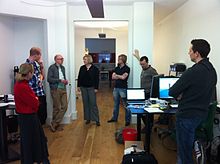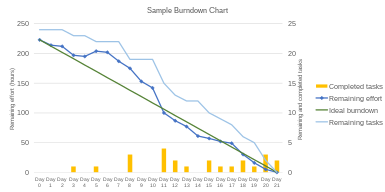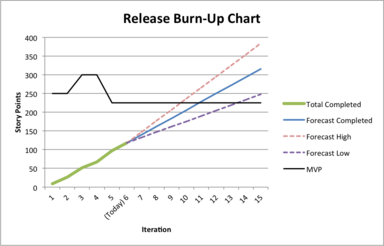In software development, a lead programmer is responsible for providing technical guidance and mentorship to a team of software developers. Alternative titles include development lead, technical lead, lead programmer, or lead application developer. When primarily contributing a low-level enterprise software design with focus on the structure of the app, e.g. design patterns, the role would be a software architect
Agile software development is the mindset for developing software that derives from values agreed upon by The Agile Alliance, a group of 17 software practitioners in 2001. As documented in their Manifesto for Agile Software Development the practitioners value:
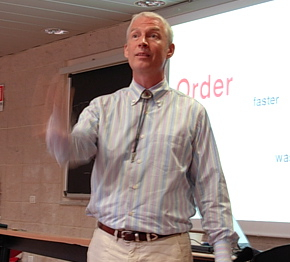
Craig Larman is a Canadian computer scientist, author, and organizational development consultant. With Bas Vodde, he is best known for formulating LeSS, and for several books on product and software development.
In agile principles, timeboxing allocates a maximum unit of time to an activity, called a timebox, within which a planned activity takes place. It is used by agile principles-based project management approaches and for personal time management.

Ken Schwaber is a software developer, product manager and industry consultant. He worked with Jeff Sutherland to formulate the initial versions of the Scrum framework and to present Scrum as a formal process at OOPSLA'95. Schwaber and Sutherland are two of the 17 initial signatories of the Agile Manifesto. They are co-authors of the Scrum Guide. Schwaber runs Scrum.org, which provides Scrum resources, training, assessments, and certifications for Scrum Masters, Scrum Developers, Scrum Product Owners, and organizations using Scrum.
Agile modeling (AM) is a methodology for modeling and documenting software systems based on best practices. It is a collection of values and principles that can be applied on an (agile) software development project. This methodology is more flexible than traditional modeling methods, making it a better fit in a fast-changing environment. It is part of the agile software development tool kit.
A product manager (PM) is a professional role that is responsible for the development of products for an organization, known as the practice of product management. Product managers own the product strategy behind a product, specify its functional requirements, and manage feature releases. Product managers coordinate work done by many other functions, and are ultimately responsible for product outcomes.

Jeff Sutherland is one of the creators of Scrum, a framework for product management. Together with Ken Schwaber, he presented Scrum at OOPSLA'95. Sutherland contributed to the creation of the Agile Manifesto in 2001. Along with Ken Schwaber, he wrote and maintains The Scrum Guide, which contains the official definition of the framework.
A stand-up meeting (stum) is a meeting in which attendees typically participate while standing. The discomfort of standing for long periods is intended to keep the meetings short.
In software engineering, a software development process or software development life cycle (SDLC) is a process of planning and managing software development. It typically involves dividing software development work into smaller, parallel, or sequential steps or sub-processes to improve design and/or product management. The methodology may include the pre-definition of specific deliverables and artifacts that are created and completed by a project team to develop or maintain an application.
The INVEST mnemonic for Agile software development projects was created by Bill Wake as a reminder of the characteristics of a good quality Product Backlog Item or PBI for short. Such PBIs may be used in a Scrum backlog, Kanban board or XP project.
ScrumEdge is a collaborative web-based scrum tool that allows agile development teams, ScrumMasters, and stakeholders to manage the Scrum lifecycle at the product and sprint levels.

Kanban is a lean method to manage and improve work across human systems. This approach aims to manage work by balancing demands with available capacity, and by improving the handling of system-level bottlenecks.
Specification by example (SBE) is a collaborative approach to defining requirements and business-oriented functional tests for software products based on capturing and illustrating requirements using realistic examples instead of abstract statements. It is applied in the context of agile software development methods, in particular behavior-driven development. This approach is particularly successful for managing requirements and functional tests on large-scale projects of significant domain and organisational complexity.
Disciplined agile delivery (DAD) is the software development portion of the Disciplined Agile Toolkit. DAD enables teams to make simplified process decisions around incremental and iterative solution delivery. DAD builds on the many practices espoused by advocates of agile software development, including scrum, agile modeling, lean software development, and others.
eXtreme Manufacturing (XM) is an iterative and incremental framework for manufacturing improvement and new product development that was inspired by the software development methodology Scrum and the systematic waste-elimination (lean) production scheduling system Kanban(かんばん ).
Within agile project management, product backlog refers to a prioritized list of functionality which a product should contain. It is sometimes referred to as a to-do list, and is considered an 'artifact' within the scrum software development framework. The product backlog is referred to with different names in different project management frameworks, such as product backlog in scrum, work item list in disciplined agile, and option pool in lean. In the scrum framework, creation and continuous maintenance of the product backlog is part of the responsibility of the product owner.
The scaled agile framework (SAFe) is a set of organization and workflow patterns intended to guide enterprises in scaling lean and agile practices. Along with disciplined agile delivery (DAD) and S@S (Scrum@Scale), SAFe is one of a growing number of frameworks that seek to address the problems encountered when scaling beyond a single team.
Agile learning generally refers to the transfer of agile methods of project work, especially Scrum, to learning processes. Likewise, agile learning proceeds in incremental steps and through an Iterative design which alternates between phases of learning and doing. The tutors rather have the role of a learning attendant or supporter. In a narrower sense, it is intended to allow competence-oriented, media-based learning in the work process within companies. In addition, the term can take several other meanings and is also often used within e-learning and online environments.
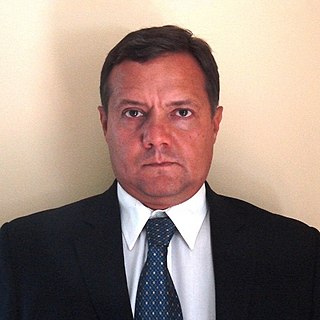
Miguel "Mike" Beedle was an American software engineer and theoretical physicist who was a co-author of the Agile Manifesto.



